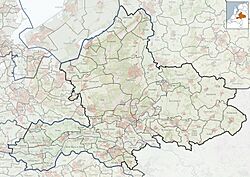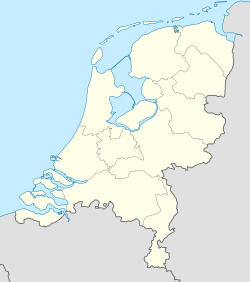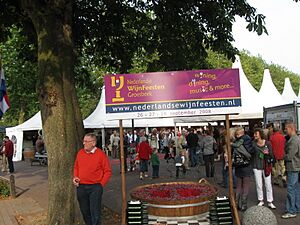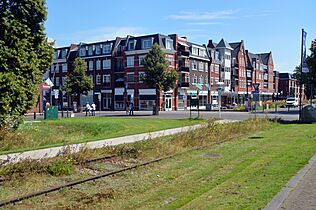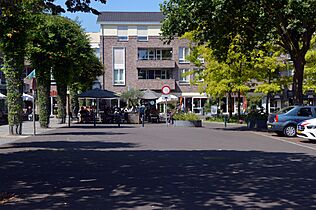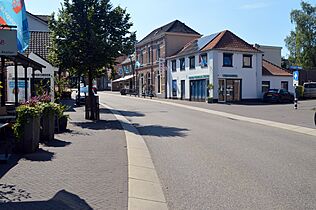Groesbeek facts for kids
Quick facts for kids
Groesbeek
|
|||
|---|---|---|---|
|
Town and former municipality
|
|||
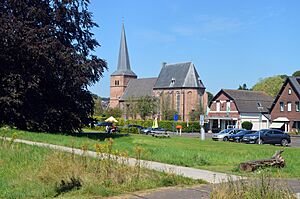
Reformed church in Groesbeek
|
|||
|
|||
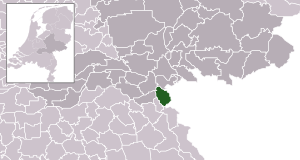
Location in Gelderland (municipality of Groesbeek before 2015)
|
|||
| Country | Netherlands | ||
| Province | Gelderland | ||
| Municipality | Berg en Dal | ||
| Area | |||
| • Total | 23.68 km2 (9.14 sq mi) | ||
| Elevation | 34 m (112 ft) | ||
| Population
(2021)
|
|||
| • Total | 12,910 | ||
| • Density | 545.2/km2 (1,412.0/sq mi) | ||
| Demonym(s) | Groesbekenaar, Groesbeker | ||
| Time zone | UTC+1 (CET) | ||
| • Summer (DST) | UTC+2 (CEST) | ||
| Postcode |
6560–6562
|
||
| Area code | 024 | ||
Groesbeek is a town in the Gelderland province of the Netherlands. It used to be its own municipality. In 2015, it joined with Millingen aan de Rijn and Ubbergen to form a larger area. This area was first called Groesbeek, but in 2016, its name changed to Berg en Dal.
Contents
About Groesbeek
Groesbeek gets its name from a small stream. The word beek means "stream" or "brook" in Dutch. This stream doesn't look the same as it used to. The town is surrounded by hills and forests. Because of this, Groesbeek was quite isolated in the past. This helped its community stay close-knit and keep a strong local dialect.
Groesbeek's Unique Landscape
Groesbeek is located in a special valley. This valley was carved out by huge glaciers during the Ice Age. The hills around the valley are actually piles of rock and dirt left by these glaciers. What's interesting is that these hills are slowly rising over time!
The valley floor is very fertile. This is because a lot of fine soil was deposited there long ago. The hills, however, have sandy soil. This means they are not good for farming. So, these hills have remained covered with thick forests. These forests helped keep Groesbeek isolated for a long time. It wasn't until a railway arrived in 1865 and a paved road was built to Nijmegen that the town became more connected.
Groesbeek in World War II
During Operation Market Garden in World War II, American paratroopers landed near Groesbeek. There was a lot of fighting, and the town was almost completely destroyed. People had to leave their homes for safety.
Today, the Freedom Museum is in Groesbeek. It's built on one of the landing sites from Operation Market Garden. The Groesbeek Canadian War Cemetery is also located here. It is a place to remember soldiers who lost their lives.
Modern Life in Groesbeek
After World War II, Groesbeek changed a lot. Better roads and more travel made it easier for people to move around. Groesbeek grew from a small farming village into a town where many people live and travel to work in nearby Nijmegen. The town is still surrounded by beautiful hills and forests. A wide band of woodlands, called Dekkerswald, separates it from Nijmegen.
Wine Making in Groesbeek
In recent years, Groesbeek has become known for making wine. It is the northernmost place in Europe where wine is made. The fertile soil and warmer summers help new types of grapes grow well here. This makes Groesbeek the only wine-making area in the Netherlands.
Sports and Festivals
Groesbeek has a strong love for football. It has several football clubs. One club, De Treffers, plays at a high amateur level in the country. Another club, Achilles '29, even played in the national first division for a while.
The town is also famous for the Nijmeegse Vierdaagse. This is a big international walking event. On the third day, walkers pass through Groesbeek and its hills.
Groesbeek also hosts one of the biggest carnival parades in the Netherlands. It takes place on the Sunday of the Catholic carnival. It's a very popular event!
Places to Visit
Groesbeek has two interesting museums:
- The Freedom Museum, which tells the story of World War II.
- The Bible Open Air Museum, which shows life in biblical times.
The Groesbeek Canadian War Cemetery and Memorial is also nearby. It is a place of remembrance for Canadian soldiers.
Gallery
See also
 In Spanish: Groesbeek para niños
In Spanish: Groesbeek para niños




